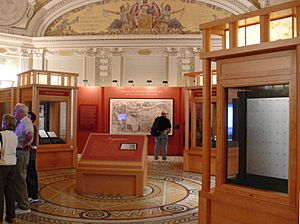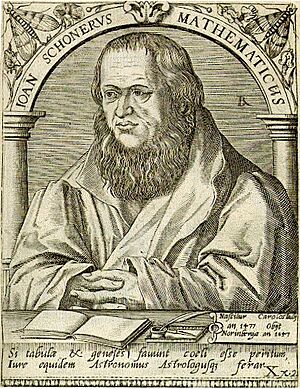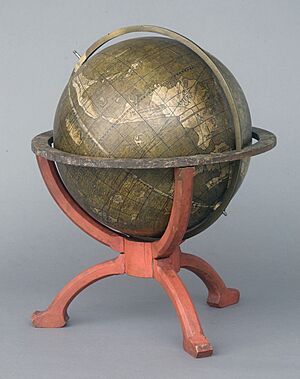Johannes Schöner facts for kids
Quick facts for kids
Johannes Schöner
|
|
|---|---|

Johannes Schöner, 1527
|
|
| Born | 16 January 1477 Karlstadt am Main
|
| Died | 16 January 1547 (aged 70) Free Imperial City of Nuremberg
|
| Nationality | Holy Roman Empire |
| Other names | Johann Schönner, Johann Schoener, Jean Schönner, Joan Schoenerus |
| Occupation | priest, astronomer, astrologer, geographer, cosmographer, cartographer, mathematician, globe & scientific instrument maker |
| Employer | Egidien Gymnasium, Nuremberg |
| Title | Professor of mathematics |
| Term | 1526–1546 |
Johannes Schöner (born January 16, 1477, in Karlstadt am Main – died January 16, 1547, in Nuremberg) was a very smart German scholar. People in his time called him a "mathematicus." This meant he studied many different subjects.
He was a priest, an astronomer (someone who studies stars), and an astrologer (someone who believes stars affect life). He was also a geographer (studies Earth's features) and a cartographer (makes maps). Schöner was known for making globes and other science tools. He also edited and published science books.
During his life, he was famous across Europe. He was known for making new and important globes. He was also seen as a top astrologer. Today, we remember him as a key person in the history of globe-making. He also helped lead to the publishing of Copernicus's famous book about the planets in 1543.
Contents
Johannes Schöner's Life
His Early Years
Schöner was born on January 16, 1477, in a town called Karlstadt am Main. We don't know much about his parents or his very early childhood. We do know he had a brother named Peter.
Schöner kept a kind of diary in one of his books. This diary tells us a lot about his adult life until 1506. He went to the University of Erfurt in 1494. He earned his first degree there in 1498.
In 1499, he started working at a school in Gemünden am Main. He became a Catholic priest in 1500. He moved to Bamberg and later became a vicar in his hometown of Karlstadt.

Schöner owned a very special map of the world from 1507. This map was made by a cartographer named Waldseemüller. It is the only copy of this map that still exists today. It was found in 1901 and is now kept at the Library of Congress in Washington, D.C.
Working in Bamberg and Nuremberg
After 1506, Schöner's diary stops. But we know he was still active in Bamberg. He even had his own printing company there. He printed many maps and globes.
In 1517, he made the first printed globe of the stars. This was a matching pair to his printed globe of the Earth from 1515. He made another globe in 1520.
In 1526, Schöner moved to Nuremberg. He was asked to be the first professor of mathematics at a new school there. He taught at this school until a year before he died. Around this time, he also became a Protestant and got married.
Schöner shared his notes about the planet Mercury with Copernicus. These notes helped Copernicus with his studies.
His Connection to Copernicus
In 1538, a young professor named Georg Joachim Rheticus visited Schöner. Rheticus was a student of Copernicus. Schöner convinced Rheticus to go visit Copernicus in Frauenburg.
In 1540, Rheticus wrote the first public report about Copernicus's work. He dedicated this report to Schöner. This was a way to see how people would react to Copernicus's new ideas. Since the report was well-received, Copernicus finally agreed to publish his main book. Rheticus then helped prepare Copernicus's book for printing.
In 1544, Schöner published some important astronomical notes. These notes were made by other famous astronomers, Regiomontanus and Walther.
Today, there is a crater on Mars named after Johannes Schöner.
See also
- Johannes Schöner globe
- Ancient world maps
- World map



